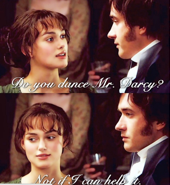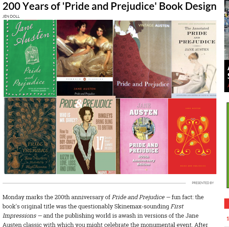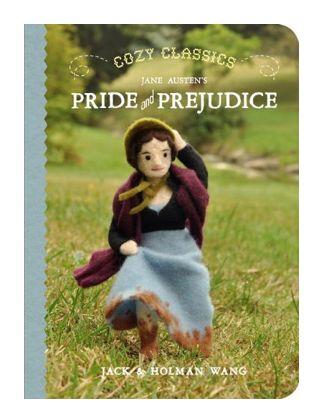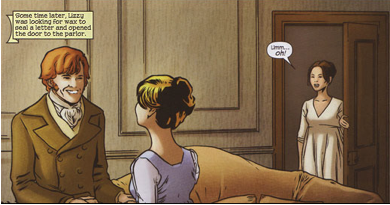
“I want to tell you I have got my own darling child from London. On Wednesday I received one copy, sent down by Falknor, with three lines from Henry to say that he had given another to Charles, & sent a 3d by the Coach to Godmersham; just the two sets which I was least eager for the disposal of.”
“I wrote to him immediately to beg for my two other Sets, unless he would take the trouble of forwarding them at once to Steventon & Portsmouth—not having an idea of his leaving Town before to day;—by your account however he was gone before my Letter was written. The only evil is the delay, nothing more can be done till his return.”
-Jane Austen, writing of her delight over her new book, 29 January 1813.

It is a testament to the iconic status Pride and Prejudice, Jane Austen’s beloved novel published in 1813,that it lends itself to so many adaptations and has never been out of print. Just this year, a modern film interpretation that mashes up zombies with Regency era courtship rituals called “Pride and Prejudice and Zombies” was released. This novel, written by an ordinary middle class woman is, according to William Deresiewizc, “the most beloved novel in the language.”Martin Amis argues this is because, “for every generation of critics, and readers, her (Jane Austen’s) fiction renews itself.” Though Charlotte Bronte violently disliked it once it had been brought to her romantic attention, Austen’s Pride and Prejudice’s popularity endures.
‘[R]ead again and for the third time at least Miss Austen’s very finely written novel of Pride and Prejudice. That young lady had a talent for describing the involvements and feelings and characters of ordinary life which is to me the most wonderful I ever met with.’ – Sir Walter Scott, quoted in Jane Austen: Social Realism and the Novel

A genre in itself related to the author, Jane Austen, is a modern mania. But arguably, it is Pride and Prejudice, originally titled “First Impressions”( though never published with that title) that has become inextricably intertwined and embedded in the popular culture.Its main characters are part of the cultural lexicon. Mr. Darcy is the ultimate romantic hero and Elizabeth Bennett is considered a modern woman and role model by many readers. To underscore the enduring popularity of this work, in 2013, a twelve foot Mr. Darcy statue adorned in a dripping wet white shirt in the form of popular Mr. Darcy actor Colin Firth appeared rising from the waters of the Serpentine Lake in London’s Hyde Park. It subsequently toured England before arriving at its ultimate home in Cheshire where the famous scene from the BBC’s 1995 version of Pride and Prejudice was filmed.
The novel (sans zombies) has inspired countless films based on the novel as well as prose adaptations such as “Bridget Jones’ Diary” and a Bollywood movie musical “Bride and Prejudice,” modern book sequels, retellings of every stripe, memes, gifs, silly plays on the well known characters, and even a stage musical.
People Love to play with Elizabeth and Darcy’s romantic dynamic!
Thug Notes Summary and Analysis
Sanitized family version of Jane Austen’s Life by her nephew titled, A Memoir of Jane Austen
Pride and Prejudice, its characters, as well as other Austen works and the author herself have a sizable social media presence. Characters have their own Facebook pages (complete with status updates), Tumblers, and Pinterest pages are devoted to quotes and memes. Products on Etsy range from dolls, to scarves emblazoned with quotes, to jewelry, shirts, and art inspired by the classic work.
Fans attend events hosted by the Jane Austen Society of North America attired in Georgian dress, to dance and learn about the era and Austen’s works. Tours of locations used in the filming of the definitive 1995 film version starring Jennifer Ehle and Colin Firth are popular among fans, but for the total immersive experience, only an Austen weekend in Vermont will do.
If you can’t attend, it is possible to imagine yourself in the novel by purchasing a customized copy of the novel that replaces the names of the main characters with your own and your loved ones.
With these facts in mind, I nominate Jane Austen’s Pride and Prejudice for the cultural icon award. On its two-hundred-year journey to its present place on the classics shelf and status as arguably the most popular novel in the English language, this work was never a “sure thing”. William Deresiewicz (2013), writing in The New Yorker on the bicentennial anniversary of its publication noted, “Two hundred years. But there seemed little chance, two hundred years ago, that many people would remember either the novel or its author by now.” And yet today Austen is franchise and a brand. Austen is an icon, a fictional heroine, film character and an industry. Dianne Sadoff (2010) observes “…the millennial Austen adaptation boom… updates and repurposes Austen’s heroine, her stories, and the author’s life story for a new century and a new spectator.”

In 1813 this ubiquitous popularity and literary fame was unthinkable. Originally titled “First Impressions” Austen (aged 21 when she wrote it) initially attempted to publish the book in 1797. It was her second novel; the first edition credited the author as the creator of Sense and Sensibility (1811), which itself was listed as “by a lady”. Her true identity did not become widely known to the public until after her death in 1817. David Sharpard notes that in her own time, Pride and Prejudice was the most popular of her works, (and her own favorite) but according to Deresiewicz, “the public soon forgot her, but her memory was kept alive…among the cognoscenti”.
“It has been an occasion for general rejoicing that Pride and Prejudice is this year celebrating its two hundredth anni- versary. Few books ofthat age attract not only scholars, but also attentive common readers whose love overflows into movies, fan fiction, beach towels, and knitting patterns. With every passing year, Austen inspires great pleasure, even almost religious devotion. (Mullen,19).”
Deborah Kaplan argues the novel’s popularity is partially socially engineered by decades of literary scholars determined to set it apart as a highbrow culture artifact, but despite this Austen’s work, particularly Pride and Prejudice is hugely popular across cultures, in many languages, with academics and audiences from gray hairs to millennials. Perhaps, as Susan Ostrov Weisser writes in “Charlotte Bronte, Jane Austen, and The Meaning of Love”, it is because of her invaluable contribution to society’s ideal of companionate marriage and ideal love, a shift to Pride and Prejudice contributed(93). Austen would recoil at the rich irony!
References
Hinnant, Charles H. (2006). Jane Austen’s ‘Wild Imagination’: Romance and the Courtship Plot in the Six Canonical Novels. Narrative 14(3) 294-310.
Jenkins, B. (2015). I Love You to Meaninglessness: From Mortal Characters to Immortal Character Types in P&P Fanfiction. Journal Of Popular Culture, 48(2), 371-384.
Kaplan, D. (2005). The Pride of Austen Critics: a Prejudice?. The Chronicle Of Higher Education, (27),
Mullen, A. (2013). A book of uncommon laughter. New Criterion, (3), 19
Nelson, C. (2013). Jane Austen … Now with Ultraviolent Zombie Mayhem. Adaptation, 6(3), 338-354.
Sadoff, Dianne F.(2010) Marketing Jane Austen at the Megaplex.
Novel: A Forum on Fiction 43:1.83-92.
Weisser, Susan Ostrov (2006). Charlotte Bronte, Jane Austen, and the Meaning of Love. Bronte Studies, (31) 93-100.




























